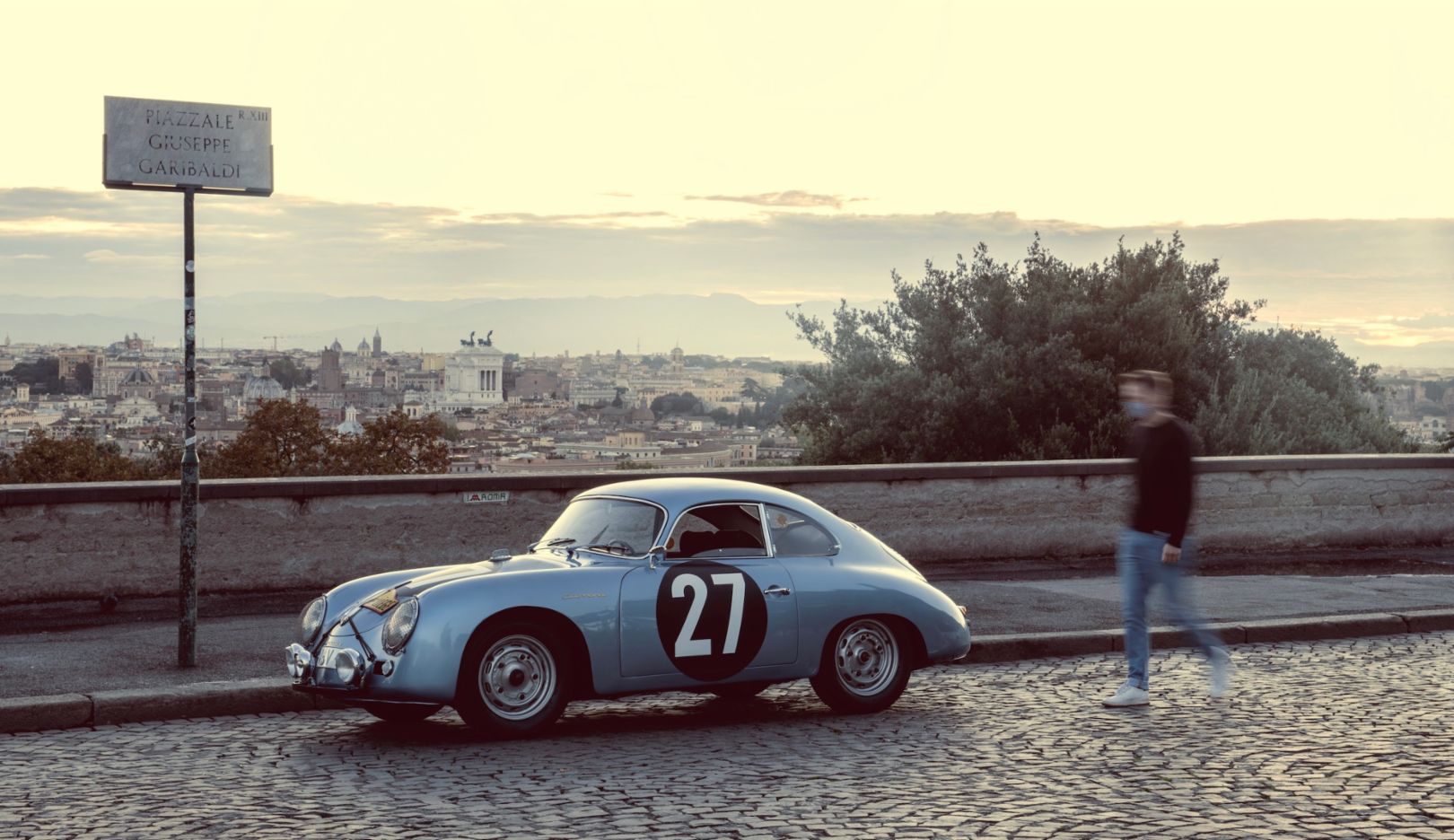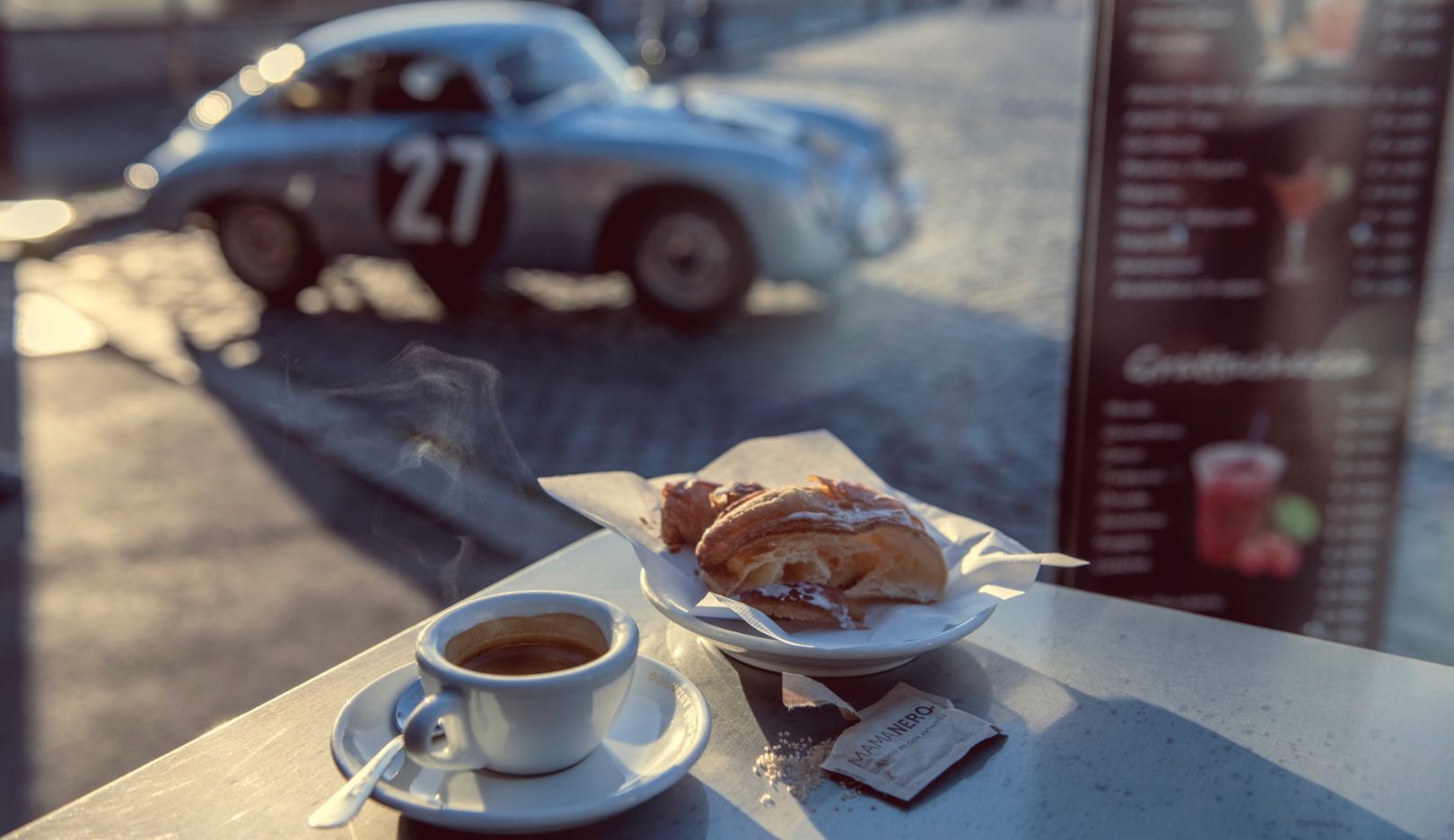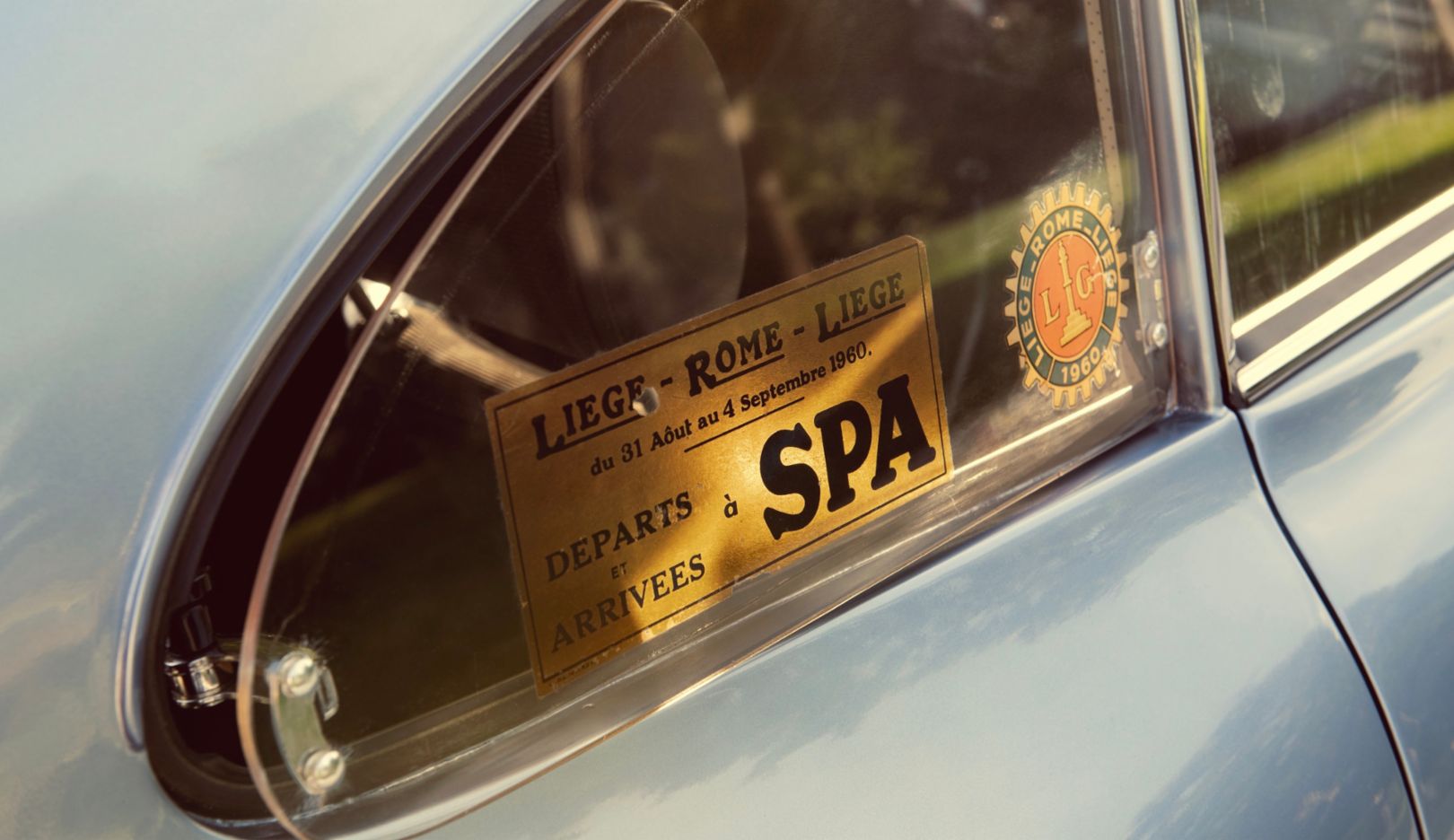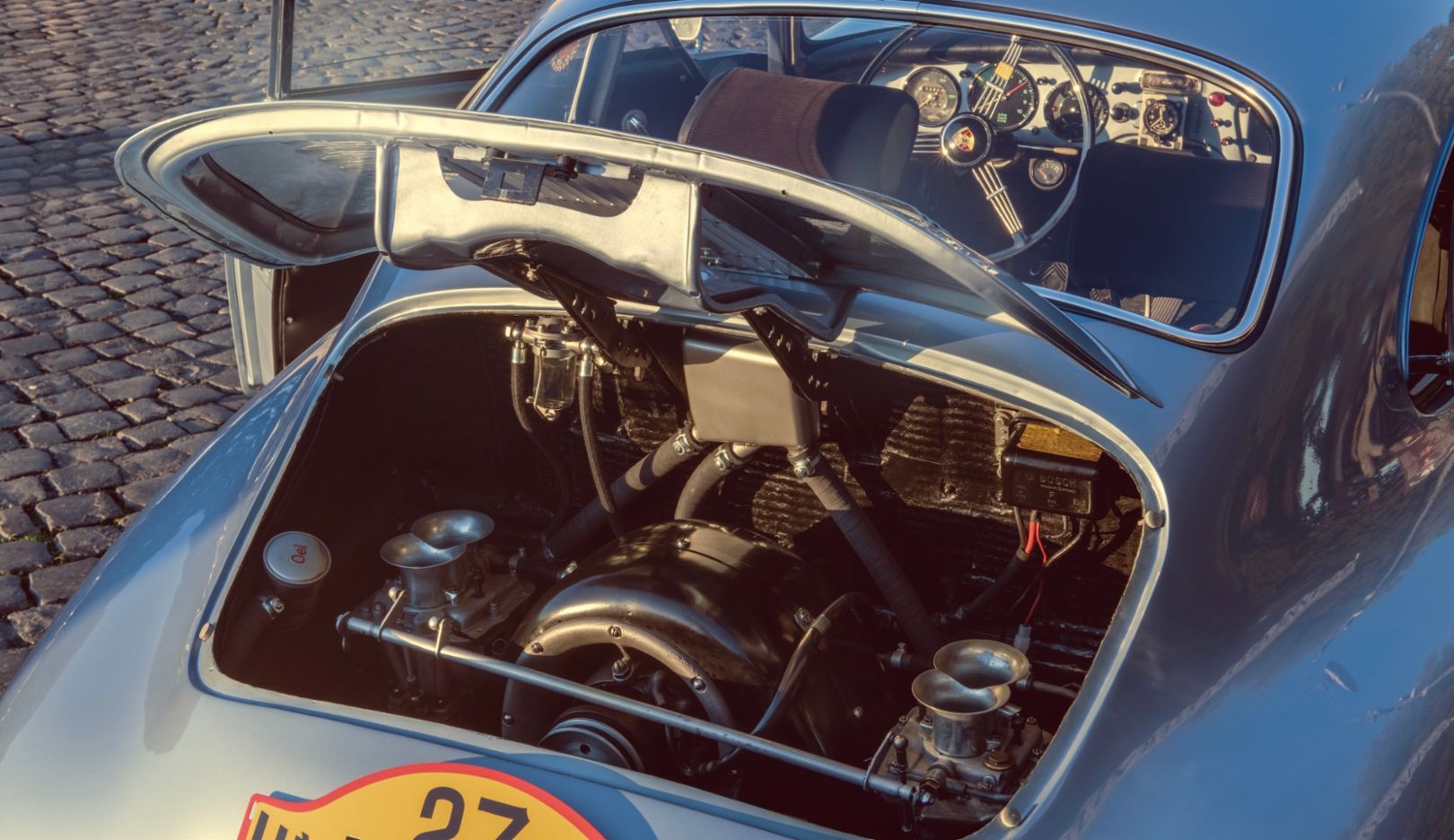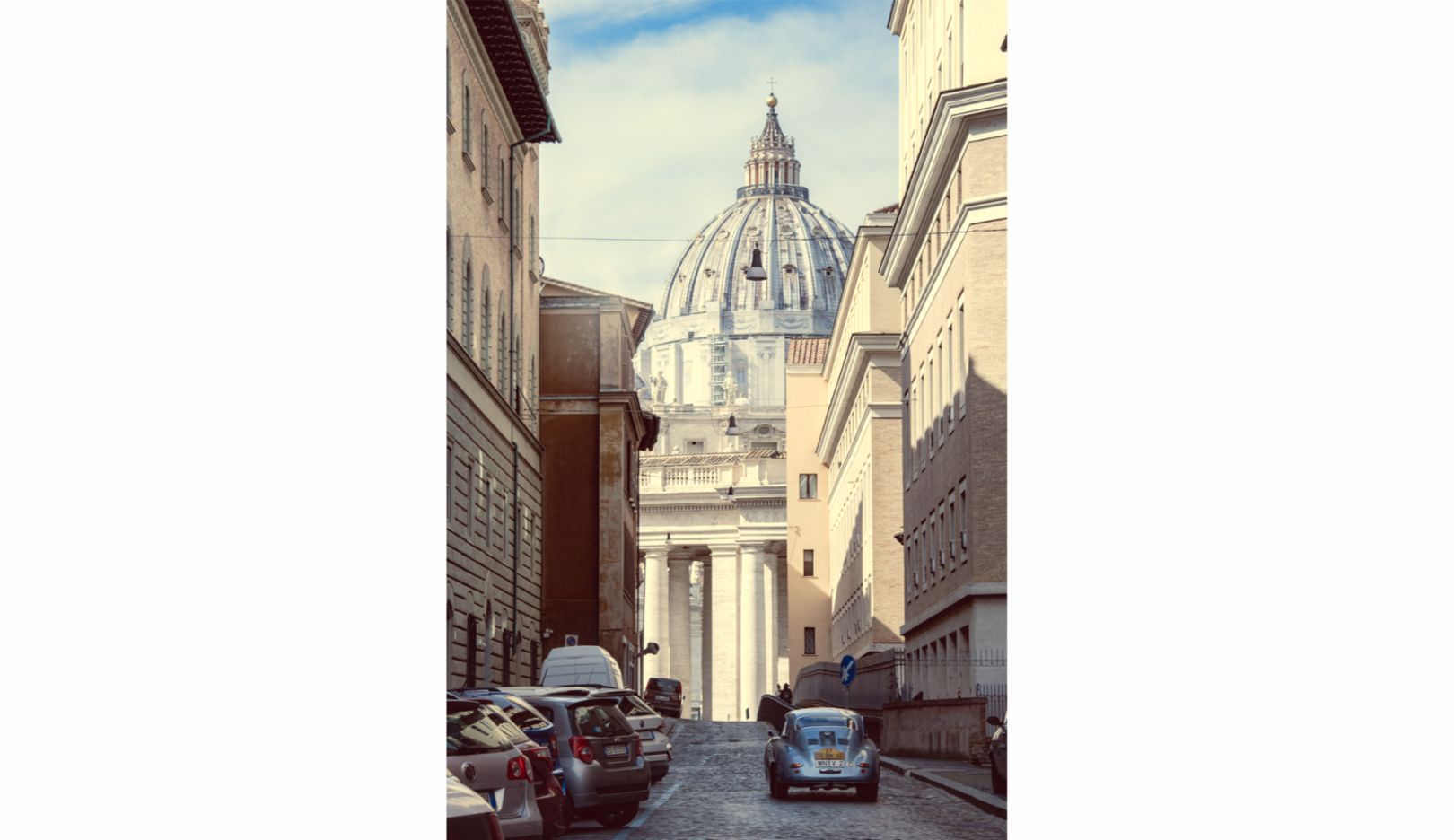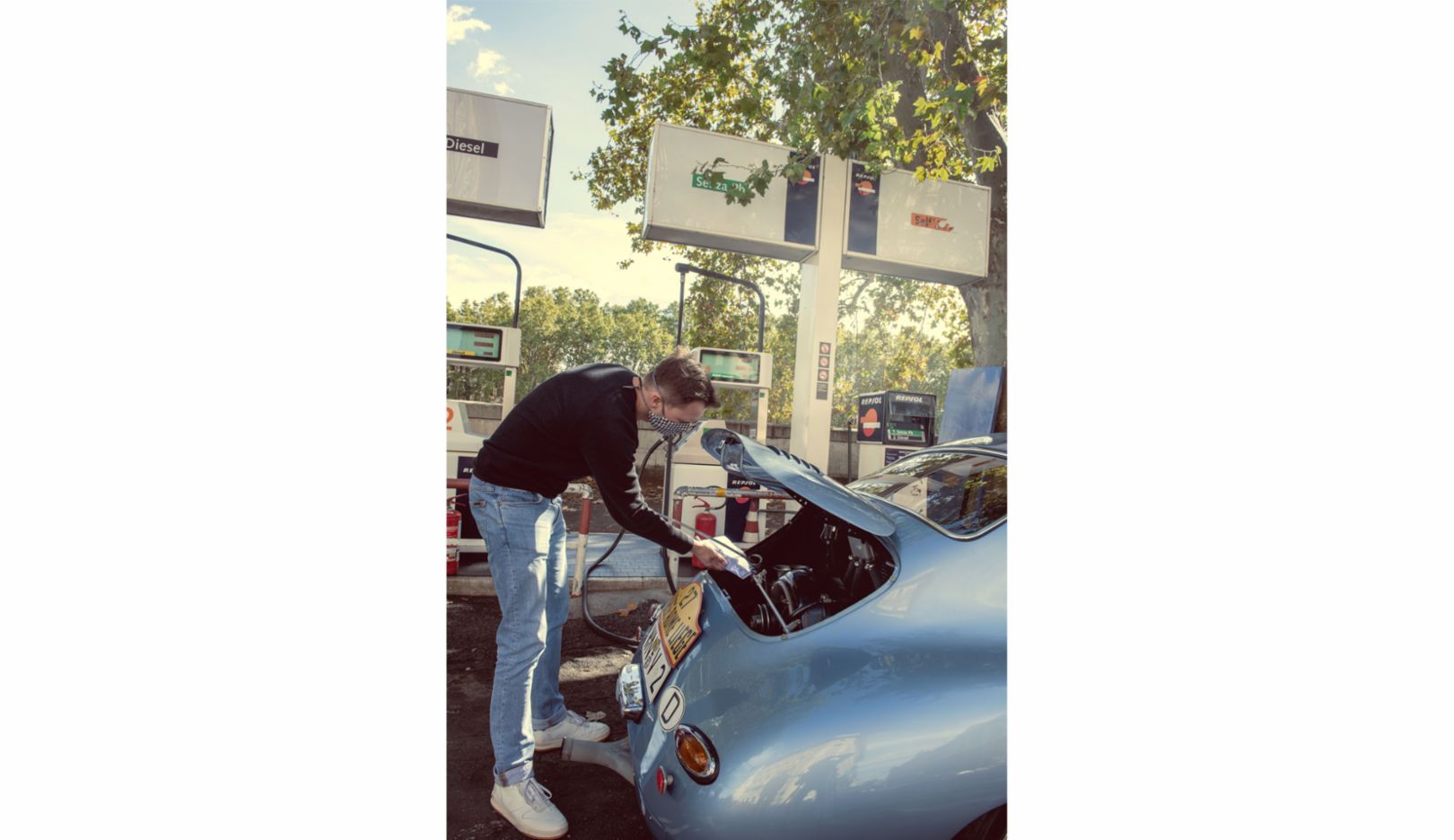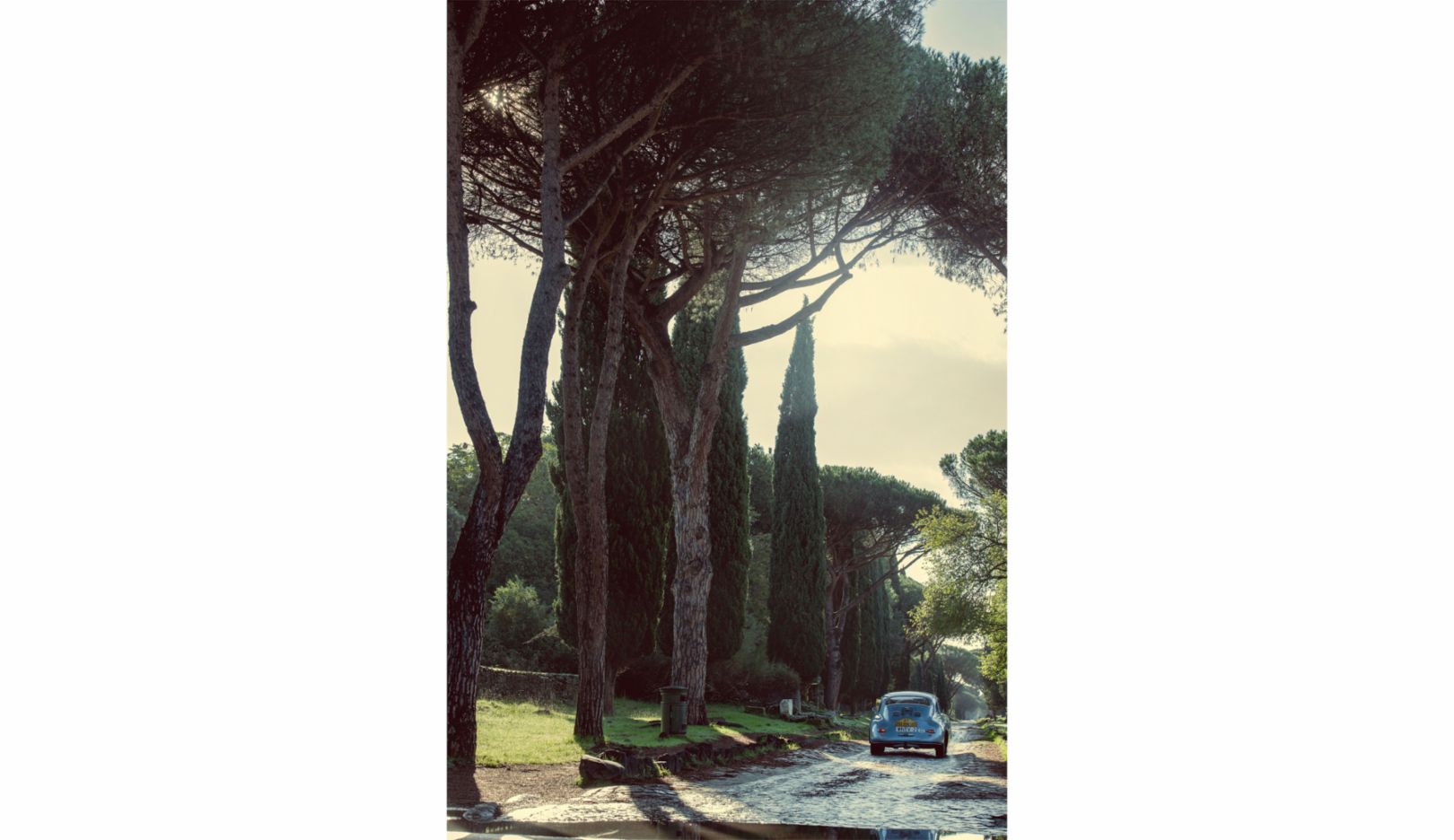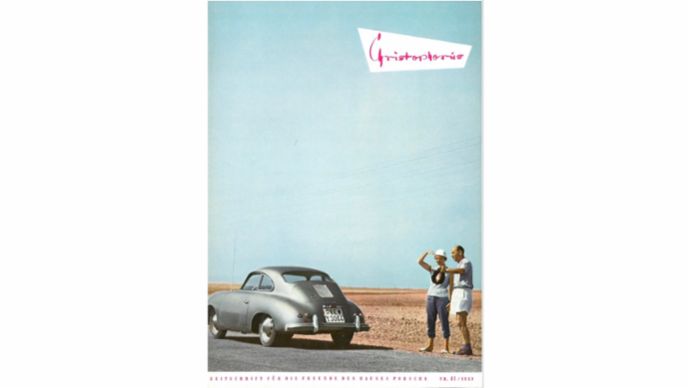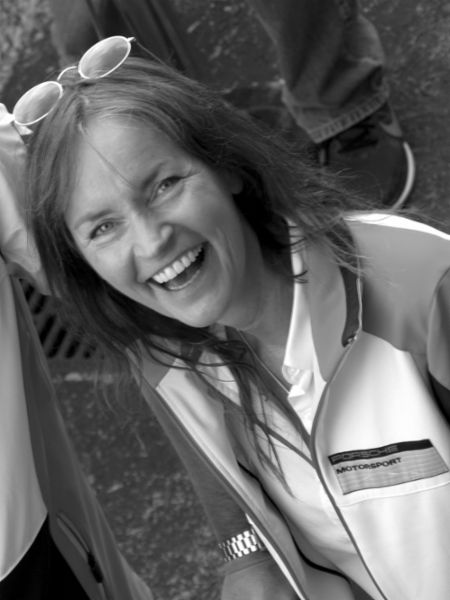Road to Rome
The past and present of Porsche customer racing come together at a rendezvous in Rome. Marc Lieb drives one of the most important racing versions of the Porsche 356. And Herbert Linge revisits the birth of the V2.
Piazzale Giuseppe Garibaldi. Marc Lieb raises a piping hot espresso to his lips, savors it, and revels in the moment. Before him, the Eternal City bathes in the glowing dawn. It’s his first time in Rome, and he’s not alone. He leans against the beauty at his side. Her nickname is “V2”—and she has over half a million kilometers on the odometer. Her full name is Porsche 356 A 1600 GS Carrera GT. Her shorter sobriquet is derived from her official license plate: WN-V2. In the world of motor racing, this car is a legend, having started in all the important European road races and rallies of its day. The long list of races in which it competed includes classics such as the Mille Miglia in Italy, the 1,000 Kilometers of Nürburgring, and the Targa Florio in Sicily.
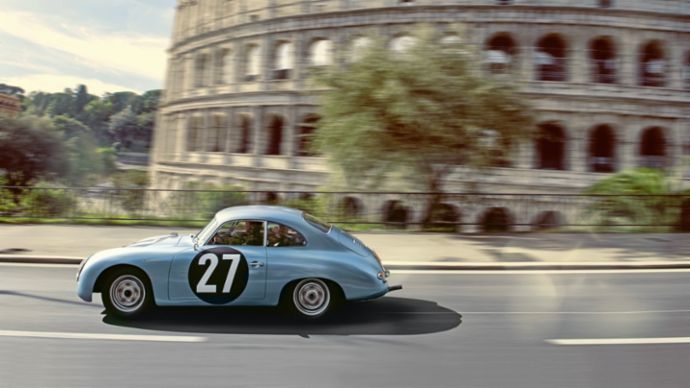
Long-awaited arrival:
Marc Lieb finally brings the Porsche 356 A 1600 GS Carrera GT to Rome—sixty-two years after the city closed its doors to the Liège–Rome–Liège rally.
“Herbert’s knowledge is an endless treasure trove.” Marc Lieb
The V2 can reach speeds of over 200 kilometers per hour. Lieb is an overall winner at Le Mans and WEC champion. The two make a fast couple, to be sure. That notwithstanding, this Christophorus story begins with a significant delay: sixty-two years, to be precise.

Role model:
Born in 1928, Herbert Linge shaped customer racing at Porsche like no one since.Let’s turn back the clock. In 1959, the Liège–Rome–Liège rally was one of the most formidable road races in the world. Over five thousand kilometers nonstop. The speed restrictions set forth by the event holder, Royal Motor Union in Belgium, were impossible to meet even on the liaison stages. Of 104 starters, only fourteen reached the finish, and none without incurring penalty points.
The overall victors that year were Paul Ernst Strähle and Robert Buchet. They did alternating stints behind the wheel for a staggering eighty-six hours. It was the greatest triumph for Strähle, then one of the most prominent German private racers in a Porsche. And it was the greatest victory for this illustrious 356. The name of the rally, incidentally, was a misnomer in the 1959 running. Roman authorities no longer wanted race cars in the city during holidays; as a result, the route was changed several times and the turnaround point was situated in what was then Yugoslavia.
But now the V2 has reached the Italian capital. Lieb is in love. With the city, with the sound of the Carrera engine, and with the unpretentious handling of this gem of a car. He is well aware of the car’s significance. After crowning his fourteen-year Porsche factory driving career with overall victory at Le Mans and the WEC title in 2016, he shifted gears and got into customer racing management. His great role model: Herbert Linge. “Undoubtedly the coolest man I ever met,” says the forty-year-old Lieb with unabashed admiration. Linge was born in 1928. He dedicated his entire working life to Porsche. After starting out as an apprentice in 1943, he became a race mechanic, a race-car driver, established the customer service organization in the USA, and was ultimately a guiding light in development.
“You could only finish Liège–Rome–Liège as a good team.” Herbert Linge
He was also Steve McQueen’s double in the driving scenes in the film Le Mans, found the land for the Weissach testing grounds, and received the German Federal Cross of Merit as the founder of the ONS Staffel (Oberste Nationale Sportbehörde crew), an organization dedicated to safety in motor racing and a part of Germany's motorsport governing body ONS, as it was known at the time. Linge knew all too well the importance of such efforts for greater safety in racing. “We drove Liège–Rome–Liège full bore, day and night, nothing was closed off—completely mad, and completely unimaginable today,” he says of the legendary rally. In 1954, he won it with Helmut Polensky. Later he contested this and many other road races together with his friend Paul Ernst Strähle. “You could only finish Liège–Rome–Liège as a good team,” says Linge. “We alternated about every three hours. You had to be able to sleep in the passenger seat. Strähle could do it. At control points I would sometimes put on his hat and sign for him—he never knew a thing. I, on the other hand, barely got a wink of sleep.”
Sleep eluded Linge not only because of the breakneck speed over narrow streets and gravel mountain passes. He was also tapped into the technical state of the V2 with every one of his senses. He knew every last screw. Linge had been a test-driver for all of the early 356s. “They knew that I had some previous knowledge from motorcycle races as well, which is why they entrusted me with it. In the early days, we built three or four cars a day. After the test-drive, I had to report to Ferry Porsche that evening which of them were okay and which ones had to go back into the shop.” The factory race and rally drivers caught wind of Linge’s skills as a mechanic, and by 1954 he was a sought-after second man in long-distance races. “They said to Herr Porsche: ‘When Linge’s on board, he takes care of everything.’”
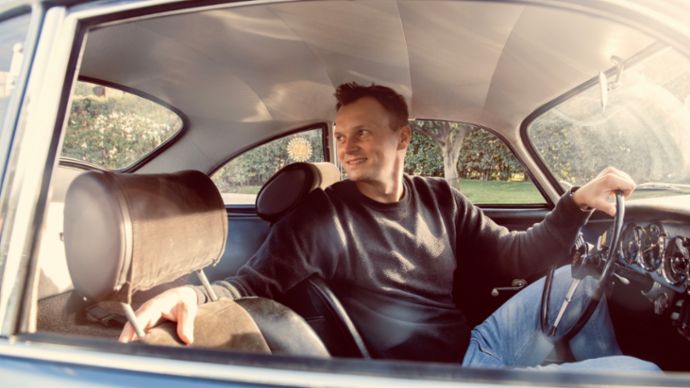
Retrospection:
Lieb drives one of the most illustrious representatives of Porsche racing history. And he is a part of that history.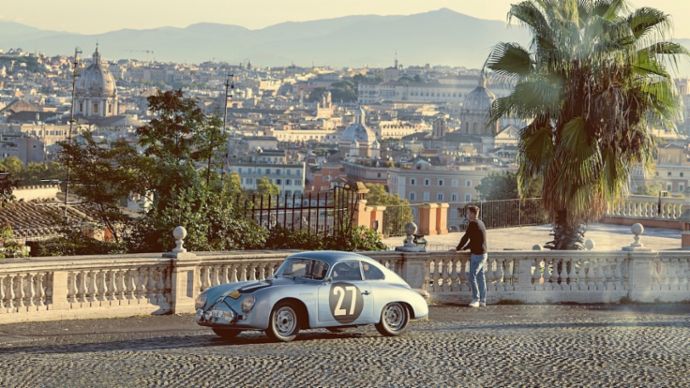
Racing legend:
The Porsche 356 V2 has finally reached its destination. The 1959 rally winner on the trail of its triumphal drive in Rome.The fact that the Weissach native was himself a top driver would soon be common knowledge as well. Plus, he was known for a driving style that was easy on the material. Even from the passenger seat, he called for gentle gear changes. “The synchronizer rings were tricky!” As a matter of course, Linge changed the brake pads four to five times over more than five thousand kilometers. “Before the mountain trials I would change the front ones at least. The car would pull when they were half-worn. We didn’t have disc brakes back then, but drums.” The venerable 125 PS, 1.6-liter engine with four overhead, vertical shaft-driven camshafts burned though spark plugs at a rapid clip. “Before each liaison stage, if we had a few minutes’ head start, I swapped out a plug. It wasn’t possible to do more at one time or we would have lost our lead.”
It’s instructive to consider the conditions in place back then: some road races were championship races, and the squads drove the V2 from Stuttgart to far-flung regions of Europe themselves entirely under their own steam. And then they drove back home. Those miles added up too. And the network of filling stations was by no means ubiquitous. Linge thought ahead: “On the special stages we always wanted to have as little fuel weight as possible in the car. Mechanics drove ahead in a VW bus and deposited twenty-liter gas canisters on the side of the road at agreed locations. Just like that—no one stole them. We all supported each other. When others were having trouble, I helped them out.” That he himself needed help at some point was the foundation of his friendship with Paul Ernst Strähle.

Timeless:
The race car with the Carrera engine represents customer racing in the early years. Lieb represents the here and now and embodies the Porsche philosophy of his role models.Linge always had the backing of his bosses. So it came to pass that he was able to borrow a company VW bus over a weekend in 1952. When the bus broke down, he was pointed to the shop of the Strähle family in Schorndorf, and it was a lucky stroke: the junior boss Paul Ernst helped him get the bus back on the road. A few weeks later came the next chance encounter. On this occasion, using his VW Beetle, Strähle pulled Linge’s and his friends’ motorcycles out of a mud pit in which the squad had gotten stuck during a rally. It goes without saying that Linge told Strähle to get in touch if he could ever be of service in Porsche matters.
“Customer racing was always a priority. That was very important to Ferry Porsche.“ Herbert Linge
In 1956, Paul Ernst Strähle, by then a seasoned driver behind the wheel, procured a used 356—but was still not competitive. With his 1.3-liter engine, he didn’t stand a chance against the 356s that were already sporting the Carrera engine out of the Porsche 550 Spyder. The new benchmark was set by the Porsche 356 A 1500 GS Carrera with 100 PS, a total weight of 850 kilograms, a top speed of 200 kilometers per hour, and a 0 to 100 kmh time of around twelve seconds. Strähle also knew that Porsche had a GS Carrera GT in the works. The GS stood for Gran Sport, GT for Gran Turismo. The planned GT version included numerous lightweight parts, a racing exhaust and, on request, a larger tank for long-distance races. Strähle was not in a position to afford any of the letters. But he knew Linge and found out that a rescue vehicle with the desired engine was for sale. The suspension and transmission were also still in working order, though the chassis had suffered irreparable fire damage. The vehicle was actually slated to be stripped for parts. But then Strähle asked Porsche for a replacement chassis, which was then ordered from Reutter with Ferry Porsche’s blessing. Thanks to the assent from the top, Strähle received a pre-series variant of the GS Carrera GT in his desired color of Adriatic Blue. “The gestation period of the V2,” as Paul Ernst Strähle, who died at the age of eighty-three in 2010, once called it.
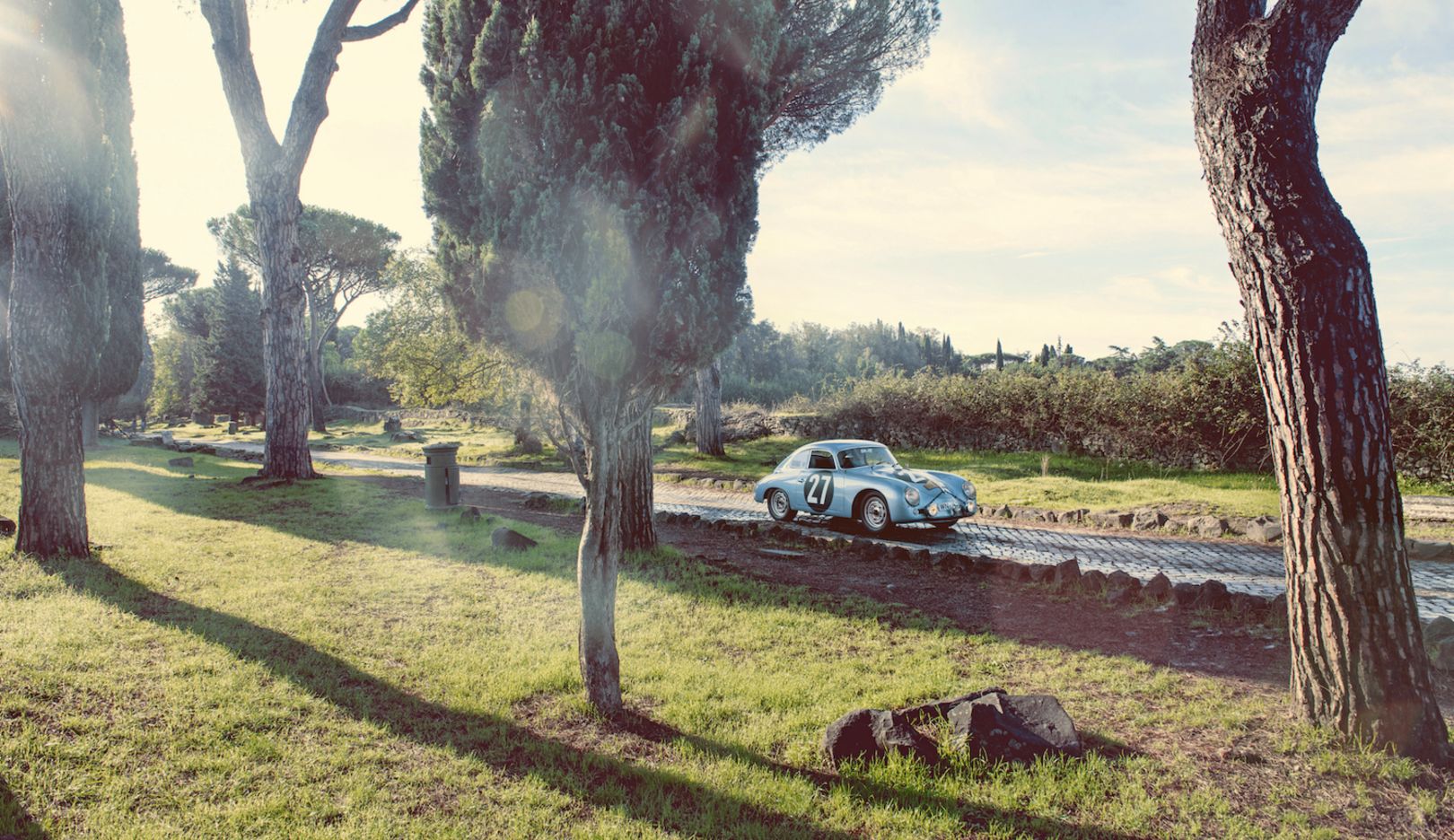
Permanence:
On the move in the Eternal City. Rome’s Via Appia Antica was built over 2,300 years ago. It accelerated trade; the V2 the success of Porsche.What was ultimately born was a race car that contained only the good stuff, and even that was relentlessly improved over the years by the two friends. After getting off work, Herbert Linge would head over to the Strähle workshop to tinker away. In 1957, the new 1.6-liter Carrera engine was installed in the car with his assistance. Linge still exudes childlike glee when he says: “We always had the best material! Sometimes we were able to install parts that the factory hadn’t even finished testing. Shock absorbers and stuff like that.” As a test-driver, he was well aware of the advantages of certain components. In 1957, the two scored the victory for the V2 with the class win and a fourteenth-place overall finish in the Mille Miglia. Many more would follow before Strähle stopped racing in 1964.
Although Linge was not as well acquainted with every Porsche race car as with the V2 at that time, one thing is a point of emphasis: “Customer racing was always a priority. Every race-car type had to be available for sale. We immediately built twenty or thirty units—even the Porsche 917 was a customer car. That was very important to Ferry Porsche. Advertising was forbidden. He always told us: ‘Our calling card is racing.’” And racing is every bit as important for the brand today.
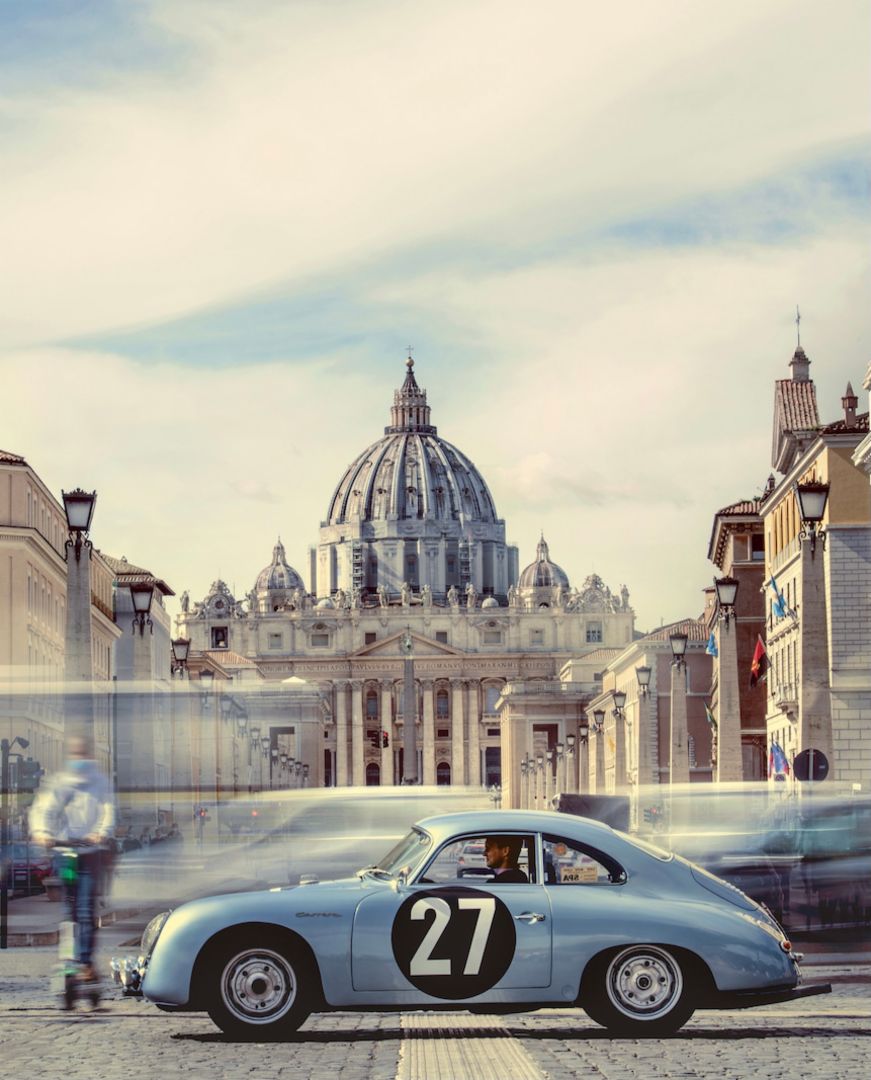
Rooflines:
On a flying visit just outside Vatican City, the 356 briefly ducks beneath the dome of St. Peter’s Basilica.Even in retirement, Linge followed how Marc Lieb became a standout in the Porsche Carrera Cup Deutschland—which Linge had once headed—how he then rose from customer racing to the factory team, and how he later scored wins and titles all around the world. Lieb says, “I’ve learned things from Herbert every time we’ve met—his knowledge is an endless treasure trove.” The qualified vehicle technology engineer looks in the rearview mirror and points the blinker to the Colosseum. The large steering wheel in the V2 is surrounded by special instruments installed by Linge and Strähle. The marking at 3,500 rpm is still on the tachometer. The Carrera engine doesn’t like anything less, as Lieb has already discovered. “Porsche now builds between 250 and 300 customer racing vehicles a year, but the philosophy is the same as it was then,” he says. “It’s not just about selling cars; it’s about strategic project planning. Those who take an interest in a model—from the Porsche 718 Cayman GT4 Clubsport to the Porsche 911 RSR, as is used by the factory team—have more than just technical questions. They want recommendations for where to use it, they want to know which factory driver is available, and they want to know what technical support exists.”
The German acronym for the department, EMV, stands for development, motorsport, and sales. And in Porsche set theory, it is responsible for the intersection of precisely these three areas. Indeed, its reach extends into the market organizations and regional managers worldwide. It was with EMV that Lieb started his second Porsche career in 2017. “Just as it was for Herbert, it’s about a shared goal with the customers, and that is to win races.” The private race-car drivers of today are, like Strähle was in his day, valuable ambassadors for the brand and have a direct line of contact to the company. Key account managers now maintain the contact, just as Linge did over sixty years ago. And like satellites launched into the racing cosmos, Porsche engineers transmit the unfiltered customer feedback directly to Weissach. Then, as now, both sides benefit from the arrangement.
Marc Lieb points the V2 swiftly in the direction of the southern outskirts of the city. He swims through traffic in the priceless gem, shifting gently but rapidly; and always double-clutching on the downshift. Unlike in 1959, there are few tourists in the city. Passersby wave; two police officers give a thumbs-up as the bella macchina hums past with its inimitable sound. The buildings of the Via Appia Antica function as a sound box. Lieb inhales deeply, as if he wanted to breathe in the over two-thousand-year history of the road. “Everything we are is an evolution of the past.” The V2 has arrived in Rome, and he has arrived in the V2. “Five hundred thousand kilometers under the hood, the old seats, the cockpit—everything is different and yet so familiar. You drive off and feel immediately: That’s a Porsche!”
SideKICK: Pyramid of customer racing
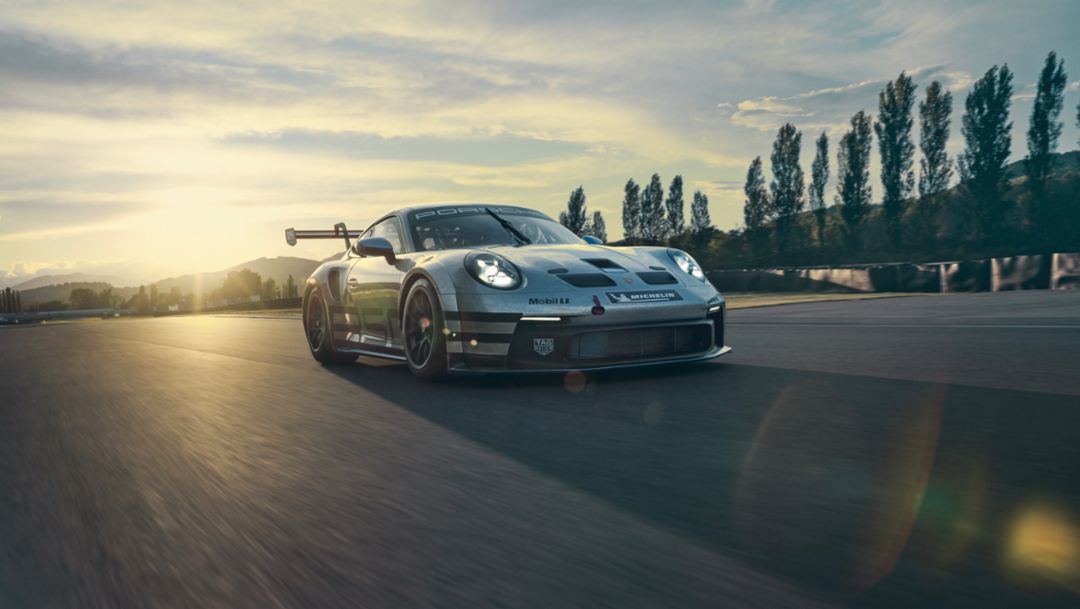
The world’s top-selling race car of all time is the Porsche 911 GT3 Cup. Its latest version for the 2021 season (photo) is based on the current 911 generation. Equipped for the first time with a Turbo-width chassis and an output of around 375 kW (510 PS), customer teams are racing this car in the Porsche Mobil 1 Supercup and have already debuted it in several of the national Porsche Carrera Cups.
The current pyramid of Porsche customer race cars begins with the 718 Cayman GT4 Clubsport and continues on to the 911 GT2 RS Clubsport. Presented in 2018 and produced in a small series of seventy-seven units, the 2019 Porsche 935—an homage to its famous predecessor—is also in the hands of speedy customers. The Cup 911 is followed by the 911 GT3 R, which established teams are competing with in international racing series. The Porsche 911 RSR is the pinnacle. It is also used by the factory team in the championship series.

